Great Lakes Storm of 1913
The Great Lakes Storm of 1913, historically referred to as the "Big Blow,"[upper-alpha 1] the "Freshwater Fury," or the "White Hurricane," was a blizzard with hurricane-force winds that devastated the Great Lakes Basin in the Midwestern United States and Ontario, Canada from November 7 through November 10, 1913. The storm was most powerful on November 9, battering and overturning ships on four of the five Great Lakes, particularly Lake Huron. Deceptive lulls in the storm and the slow pace of weather reports contributed to the storm's destructiveness.[1]
 Convergence of systems to form the November gale | |
| Type | Cyclonic blizzard |
|---|---|
| Formed | November 6, 1913 |
| Dissipated | November 11, 1913 |
| Lowest pressure | 968.5 mb (28.60 inches) |
| Highest winds |
|
| Maximum snowfall or ice accretion | 24 in (61 cm) of snow recorded in some areas |
| Damage | vessels:
shore damage: Complete cost not available. |
| Casualties | over 250 fatalities |
| Areas affected | The Great Lakes Basin in the Midwestern United States and the Canadian province of Ontario |
The deadliest and most destructive natural disaster to hit the lakes in recorded history,[2] the Great Lakes Storm killed more than 250 people,[3][4][5][6][7] destroyed 19 ships, and stranded 19 others. The financial loss in vessels alone was nearly US $5 million (or about $129,343,000 in today's dollars).[8] This included about $1 million at current value in lost cargo totalling about 68,300 tons, such as coal, iron ore, and grain.[9]
The storm, an extratropical cyclone, originated as the convergence of two major storm fronts, fueled by the lakes' relatively warm waters—a seasonal process called a "November gale". It produced 90 mph (140 km/h) wind gusts, waves over 35 feet (11 m) high, and whiteout snowsqualls. Analysis of the storm and its impact on humans, engineering structures, and the landscape led to better forecasting and faster responses to storm warnings, stronger construction (especially of marine vessels), and improved preparedness.
Background
The immense volume of water in the five Great Lakes holds heat that allows the lakes to remain relatively warm for much later into the year and postpones the Arctic spread in the region.[10] During the autumn months, two major weather tracks converge over the area. Cold, dry air moves south/southeast from Alberta and northern Canada as an Alberta clipper; warm, moist air moves north/northeast from the Gulf of Mexico, along the lee of the central Rocky Mountains, as a Colorado low. The collision of these masses forms large storm systems in the middle of the North American continent, including the Great Lakes.[10] When the cold air from these storms moves over the lakes, it is warmed by the waters below[11] and picks up a spin.[10] As the cyclonic system continues over the lakes, its power is intensified by the jet stream above and the warm waters below.
The result is commonly referred to as a "November gale" or "November witch." Such a storm can maintain hurricane-force wind gusts, produce waves over 50 feet (15 m) high, and dump several inches of rain or feet of snow. Fueled by the warm lake water, these powerful storms may remain over the Great Lakes for days. Intense winds ravage the lakes and surrounding shores, severely eroding and flooding the shorelines.[10][11]
November gales have been a bane of the Great Lakes, with at least 25 killer storms striking the region since 1847.[10] During the Big Blow of 1905, 27 wooden vessels were lost. During a November gale in 1975, the giant ore bulk carrier SS Edmund Fitzgerald sank suddenly with all hands, without a distress signal.[11][12]
Prelude to the storm
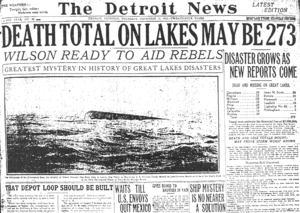
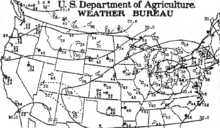

The storm was first noticed on Thursday, November 6, on the western side of Lake Superior, moving rapidly toward northern Lake Michigan. The weather forecast in The Detroit News called for "moderate to brisk" winds for the Great Lakes, with occasional rains Thursday night or Friday for the upper lakes (except on southern Lake Huron), and fair to unsettled conditions for the lower lakes.[13]
Around midnight, the steamer Cornell, while 50 miles (80 km) west of Whitefish Point in Lake Superior, ran into a sudden northerly gale and was badly damaged. This gale lasted until late November 10, almost forcing Cornell ashore.
Storm
November 7


On Friday, the weather forecast in the Port Huron Times-Herald of Port Huron, Michigan, described the storm as "moderately severe."[14] By then, the storm was centered over the upper Mississippi Valley and had caused moderate to brisk southerly winds with warmer weather over the lakes. The forecast predicted increased winds and falling temperatures over the next 24 hours.
At 10:00 a.m., Coast Guard stations and United States Department of Agriculture (USDA) Weather Bureau offices at Lake Superior ports raised white pennants above square red flags with black centers, indicating a storm warning with northwesterly winds. By late afternoon, the storm signal flags were replaced with a vertical sequence of red, white, and red lanterns, indicating that a hurricane with winds over 74 mph (119 km/h) was coming. (The word hurricane here does not refer to a tropical cyclone, but to Force 12 winds on the Beaufort scale.) The winds on Lake Superior had already reached 50 mph (80 km/h), and an accompanying blizzard was moving toward Lake Huron.[15]
November 8
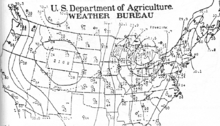
By Saturday, the storm's status had been upgraded to "severe". The storm was centered over eastern Lake Superior, covering the entire lake basin. The weather forecast of the Port Huron Times-Herald stated that southerly winds had remained "moderate to brisk".[16] Northwesterly winds had reached gale strength on northern Lake Michigan and western Lake Superior, with winds of up to 60 mph (97 km/h) at Duluth, Minnesota.
A false lull in the storm (a "sucker hole") allowed traffic to begin flowing again, both down the St. Marys River and up Lake Erie, and the Detroit and St. Clair rivers, into Lake Huron. Gale wind flags were raised at more than a hundred ports, but were ignored by many ship captains. Long ships traveled all that day through the St. Marys River, all night through the Straits of Mackinac, and early Sunday morning up the Detroit and St. Clair rivers.[17]

November 9
By noon on Sunday, weather conditions on lower Lake Huron were close to normal for a November gale. Barometric pressures in some areas began to rise, bringing hope of an end to the storm. The low pressure area that had moved across Lake Superior was moving northeast, away from the lakes.
The Weather Bureau had issued the first of its twice-daily reports at approximately 8:00 a.m.; it did not send another report to Washington, D.C. until 8:00 p.m. This proved to be a serious problem: the storm would have the better part of a day to build up hurricane forces before the Bureau headquarters in Washington, D.C., would have detailed information.[18]
Along southeastern Lake Erie, near the city of Erie, Pennsylvania, a southern low-pressure area was moving toward the lake. This low had formed overnight, so was absent from Friday's weather map. It had been traveling northward and began moving northwestward after passing over Washington, D.C.
The intense counterclockwise rotation of the low was made apparent by the changing wind directions around its center. In Buffalo, New York, morning northwest winds had shifted to northeast by noon and were blowing southeast by 5:00 p.m., with the fastest gusts, 80 mph (130 km/h), occurring between 1:00 p.m. and 2:00 p.m. Just 180 miles (290 km) to the southwest, in Cleveland, Ohio, winds remained northwest during the day, shifting to the west by 5:00 p.m., and maintaining speeds of more than 50 mph (80 km/h). The fastest gust in Cleveland, 79 mph (127 km/h), occurred at 4:40 p.m. There was a dramatic drop in barometric pressure at Buffalo, from 29.52 inHg (999.7 hPa) at 8:00 a.m. to 28.77 inHg (974.3 hPa) at 8:00 p.m.
The rotating low continued along its northward path into the evening, bringing its counterclockwise winds in phase with the northwesterly winds already hitting Lakes Superior and Huron. This resulted in an explosive increase in northerly wind speeds and swirling snow. Ships on Lake Huron that were south of Alpena, Michigan—especially around Harbor Beach and Port Huron in Michigan and Goderich and Sarnia in Ontario—were battered with massive waves moving southward toward St. Clair River.
Some ships had sought shelter along the coast in Michigan or along the Goderich to Point Edward coast but few survived the powerful north winds. Three of the larger ships were found upside down, indicative of extremely high winds and tall waves.[1]
From 8:00 p.m. to midnight, the storm became what modern meteorologists call a "weather bomb". Sustained hurricane-speed winds of more than 70 mph (110 km/h) ravaged the four western lakes. The worst damage was done on Lake Huron as numerous ships scrambled for shelter along its southern end. Gusts of 90 mph (140 km/h) were reported off Harbor Beach, Michigan. The lake's shape allowed northerly winds to increase unchecked, because of the lower surface friction of water compared to land, and the wind following the lake's long axis.[19]
In retrospect, weather forecasters of the time did not have enough data or understanding of atmospheric dynamics to predict or comprehend the events of Sunday, November 9. Frontal mechanisms, referred to then as "squall lines", were not yet understood. Surface observations were collected only twice daily at stations around the country, and by the time these data were collected and hand-drawn maps created, the information lagged actual weather conditions by hours.[20]
November 10 and 11
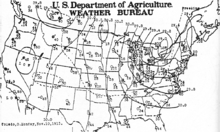

On Monday morning, the storm had moved northeast of London, Ontario, dragging lake effect blizzards in its wake. An additional 17 inches (43 cm) of snow were dumped on Cleveland, Ohio that day, filling the streets with snowdrifts 6 feet (1.8 m) high. Streetcar operators stayed with their stranded, powerless vehicles for two nights, eating whatever food was provided by local residents. Travelers were forced to take shelter and wait for things to clear.
By Tuesday, the storm was rapidly moving across eastern Canada. Without the warm lake waters, it lost strength quickly. This also meant less snowfall, both because of the fast motion of the storm and the lack of lake effect snow. All shipping was halted on Monday and part of Tuesday along the St. Lawrence River around Montreal, Quebec.[21]
Aftermath
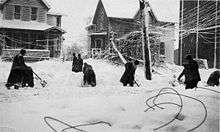
Historically, storms of such magnitude and with such high wind velocities have not lasted more than four or five hours. The Great Lakes storm, however, raged for more than 16 hours, with an average speed of 60 mph (97 km/h), and frequent bursts of more than 70 mph (110 km/h). It crippled traffic on the lakes and throughout the Great Lakes basin region.
Surrounding shoreline

Along the shoreline, blizzards shut down traffic and communication, causing hundreds of thousands of dollars in damage. A 22-inch (56 cm) snowfall in Cleveland, Ohio, put stores out of business for two days. There were four-foot (120 cm) snowdrifts around Lake Huron. Power was out for several days across Michigan and Ontario, cutting off telephone and telegraph communications. A recently completed US$100,000 Chicago breakwater, intended to protect the Lincoln Park basin from storms, was swept away in a few hours.[22] The Milwaukee, Wisconsin harbor lost its entire south breakwater and much of the surrounding South Park area that had been recently renovated.[23]
After the final blizzards hit Cleveland, the city was paralyzed under feet of ice and snow and was without power for days. Telephone poles had been broken, and power cables lay in tangled masses. The November 11 Plain Dealer described the aftermath:
- "Cleveland lay in white and mighty solitude, mute and deaf to the outside world, a city of lonesome snowiness, storm-swept from end to end, when the violence of the two-day blizzard lessened late yesterday afternoon."[24]
William H. Alexander, Cleveland's chief weather forecaster, observed:
- "Take it all in all—the depth of the snowfall, the tremendous wind, the amount of damage done and the total unpreparedness of the people—I think it is safe to say that the present storm is the worst experienced in Cleveland during the whole forty-three years the Weather Bureau has been established in the city."[25]
On the lakes
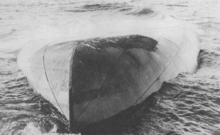
The greatest damage was done on the lakes. Major shipwrecks occurred on all but Lake Ontario, with most happening on southern and western Lake Huron. Lake masters recounted that waves reached at least 35 feet (11 m) in height. Being shorter in length than waves ordinarily formed by gales, they occurred in rapid succession, with three waves frequently striking in succession. Masters also stated that the wind often blew in directions opposite to the waves below. This was the result of the storm's cyclonic motion, a phenomenon rarely seen on the Great Lakes.
In the late afternoon of November 10, an unknown vessel was spotted floating upside-down in about 60 feet (18 m) of water on the eastern coast of Michigan, within sight of Huronia Beach and the mouth of the St. Clair River. Determining the identity of this "mystery ship" became of regional interest, resulting in daily front-page newspaper articles. The ship eventually sank, and it was not until early Saturday morning, November 15, that it was finally identified as Charles S. Price. (This was the first time in Great Lakes history that a fully loaded ore carrier had been capsized.)[26] The front page of that day's Port Huron Times-Herald extra edition read, "BOAT IS PRICE — DIVER IS BAKER — SECRET KNOWN".[27] Milton Smith, an assistant engineer who decided at the last moment not to join his crew on premonition of disaster, aided in identifying any bodies that were found.
The final tally of financial loss included US$2,332,000 for vessels totally lost, $830,900 for vessels that became constructive total losses, $620,000 for vessels stranded but returned to service, and approximately $1,000,000 in lost cargoes. This figure did not include financial losses in coastal cities.[28]
The storm had several long-term consequences. Complaints against the USDA Weather Bureau of alleged unpreparedness resulted in increased efforts to achieve more accurate weather forecasting and faster realization and communication of proper storm warnings. Criticism of the shipping companies and shipbuilders led to a series of conferences with insurers and mariners to seek safer designs for vessels. This resulted in the construction of ships with greater stability and more longitudinal strength. Immediately following the blizzard of Cleveland, Ohio, the city began a campaign to move all utility cables underground, in tubes beneath major streets. The project took half a decade.
Ships foundered
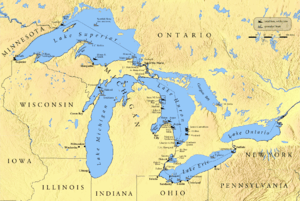
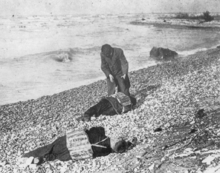
The following list includes ships (in order of number of victims) that sank during the storm, killing their entire crews. It does not include the three victims from the freighter William Nottingham, who volunteered to leave the ship on a lifeboat in search of assistance. While the boat was being lowered into the water, a breaking wave smashed it into the side of the ship. The men disappeared into the near-freezing waters below. The following shipwreck casualties have been documented:[29]
| Name | Body of water | Number of victims | Year located | Coordinates | Image |
|---|---|---|---|---|---|
| Isaac M. Scott | Lake Huron | 28 | 1976[30] | 45.065333°N 83.039217°W | 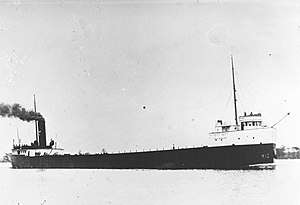 |
| Charles S. Price | Lake Huron | 28 | 1913[30] | 43.1529°N 82.3529°W | 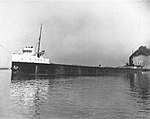 |
| Argus | Lake Huron | 28 | 1972[30] | 44.433333°N 82.8°W | 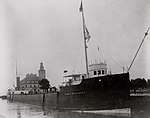 |
| Henry B. Smith | Lake Superior | 25 | 2013[30] | 46.914°N 87.333°W | 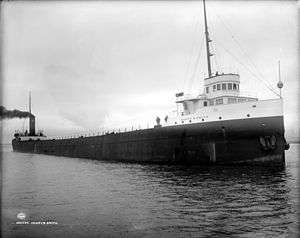 |
| Hydrus | Lake Huron | 25 | 2015[31] | 43.283333°N 82.433333°W |  |
| John A. McGean | Lake Huron | 23 | 1985[30] | 43.953267°N 82.528617°W |  |
| James Carruthers | Lake Huron | 22 | Not located | _ |  |
| Regina | Lake Huron | 20 | 1986[32] | 43.337333°N 82.446°W | 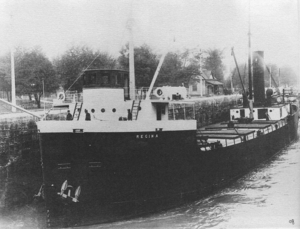 |
| Wexford | Lake Huron | 20 | 2000[30] | 43.416667°N 81.916667°W |  |
| Leafield | Lake Superior | 18 | Not located | _ |  |
| Plymouth | Lake Michigan | 7 | Not located | _ |  |
| LV-82 Buffalo | Lake Erie | 6[33] | 1914[30] | Raised and later scrapped | 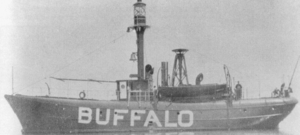 |
Of the twelve ships that sank in the storm, three have never been found: Leafield, Plymouth and James Carruthers. The Plymouth was believed to have been located off of Poverty island,[34] but there is no evidence of the wreck being the Plymouth. The most recent discovery is Hydrus, which was located in mid-2015.[31] The last wreck found previous to Hydrus was Henry B. Smith in 2013.[35] Among the debris cast up by the storm was wreckage of the fish tug Searchlight lost in April 1907.[36]
See also
- List of storms on the Great Lakes
- Shipwrecks of the 1913 Great Lakes storm
- List of lighthouses in Ontario
References
Notes
- Another storm called the "Big Blow" was on October 15, 1880, which sank SS Alpena, with enormous loss of life.
Citations
- Scott, Chris (November 10, 2014). "The White Hurricane: The worst storm in Great Lakes history". Weather Network News. The Weather Network. Retrieved March 23, 2017.
The Great Storm of 1913, known as the ‘White Hurricane’
- Brown, David G. (2002). White Hurricane. International Marine / McGraw-Hill. pp. 208, 222. ISBN 0-07-138037-X.
- Brown, 2002.
- The Great Storm of 1913: Vessels Totally Destroyed. Newsletter, Winter 2003, Save Ontario Shipwrecks, Inc.. Accessed on February 9, 2005. Archived April 24, 2005, at the Wayback Machine
- Hemming, Robert J. (1992). Ships Gone Missing: The Great Lakes Storm of 1913. Chicago: Contemporary Books, Inc. ISBN 0-8092-3909-4.
- Shipwrecks. Maritime History of the Great Lakes. Accessed on February 10, 2005. Archived February 6, 2005, at the Wayback Machine
- Annual Report of the Lake Carriers' Association. 1913.
- Brown, 2002, p 245, Oregon State University. Retrieved 2007-04-10. Archived October 5, 2007, at the Wayback Machine
- Brown, 2002, pp 203, 225.
- Heidorn, Keith C. (2001). "The Great Lakes: Storm Breeding Ground". Science of the Sky. Published online 16 Nov 2001, Suite101. Retrieved 5 February 2005.
- Bentley, Mace and Steve Horstmeyer. "The witch of November." Weatherwise Magazine. Nov/Dec 1998. doi:10.1080/00431672.1998.9926174.
- Brown, 2002, p. 246.
- Weather forecast, The Detroit News, Detroit, Michigan, 5 Nov 1913.
- Front page, Port Huron Times-Herald, Port Huron, Michigan. 7 November 1913.
- See Brown, 2002, pp. 28–44, for wind speeds and other figures for November 7.
- Front page, Port Huron Times-Herald, Port Huron, Michigan, 8 November 1913.
- See Brown, 2002, pp. 44–67, for wind speeds and other figures for November 8.
- Brown, 2002, p. 12.
- See Brown, 2002, pp. 68–127, for wind speeds and other figures for November 9.
- Brown, 2002, pp. 13, 19, 68.
- See Brown, 2002, pp. 127–142, 163–180, for wind speeds and other figures for November 10 and November 11.
- Brown, 2002, p. 94.
- Barcus, 1986, p. 6.
- Reprinted in Brown, 2002, p. 162.
- Reprinted in Brown, 2002, p. 163.
- Minnich, Jerry The Wisconsin Almanac, p. 218 ISBN 0-944133-06-1.
- Front page, Port Huron Times-Herald EXTRA edition, Port Huron, Michigan, 15 November 1913.
- Brown, 2002, p. 245.
- Brown, 2002, p. 223.
- "Shipwrecks of the 1913 storm". National Oceanic and Atmospheric Administration. Retrieved December 1, 2019.
- Schaefer, Jim (November 9, 2015). "Man discovers Lake Huron shipwreck missing since 1913". Detroit Free Press. Retrieved 2015-11-09.
- "History & Salvage of the SS Regina". Shipwrecks.com. Retrieved December 1, 2019.
- Vogel, Michael N. and Paul F. Redding, Maritime Buffalo, Buffalo History, Lightship LV 82.
- ODMP memorial
- Krueger, Andrew (June 9, 2013). "100 years after ore boat disappeared in Lake Superior storm, searchers locate wreck". Duluth News Tribune. Archived from the original on June 10, 2013.
- "Harbor Beach, MI (Lake Huron) Fishing Tug Searchlight Lost, Apr 1907". Daily Chronicle. Marshall, Michigan. 25 April 1907. Retrieved 19 July 2019 – via Gendisasters.com.
References
- Barcus, Frank, Freshwater Fury: Yarns and Reminiscences of the Greatest Storm in Inland Navigation, (1986: Wayne State University Press) 166 pages. ISBN 0-8143-1828-2.
- Brown, David G. (2002). White Hurricane: A Great Lakes November Gale and America's Deadliest Maritime Disaster. International Marine / McGraw-Hill. ISBN 0-07-138037-X.
- Hemming, Robert J. (1992). Ships Gone Missing: The Great Lakes Storm of 1913. Chicago: Contemporary Books, Inc. 198 pages. ISBN 0-8092-3909-4.
- Ratigan, William (1987). Great Lakes Shipwrecks and Survivals. Grand Rapids: William B. Eerdmans Publishing Co. ISBN 0-8028-7010-4.
- Shipley, Robert and Fred Addis (1992). Wrecks and Disasters: Great Lakes Album Series. St. Catharines, Ontario: Vanwell Publishing Limited. ISBN 0-920277-77-2.
- Articles in The Port Huron Times-Herald. Port Huron, Michigan. (Nov. 10–15, 1913). various authors and pages. Transcripts of relevant articles are available online.
External links
| Wikimedia Commons has media related to Great Lakes Storm of 1913. |
| Wikiquote has quotations related to: Great Lakes Storm of 1913 |
- A first-person account of the storm, from a 1914 article in the Marine Review.
- The Wexford: Elusive Shipwreck of the 1913 Great Storm.
- List of victims of the 1913 Great Lakes storm @ rootsweb.com.
- Personal experiences of Captains of the Lake Fleet.
- Photos of various discovered shipwrecks.
- Tales of sea and riverside, Great Storm of 1913 (pictures of all the ships lost.)
- The Great Blizzard of 1978, details the cause of the November gale.
- "Isaac M. Scott". Thunder Bay National Marine Sanctuary and Underwater Preserve. Retrieved February 10, 2005.
- Deedler, William R. (Weather Historian, WFO Pontiac/Detroit Mi) Hell Hath' No Fury Like a Great Lakes Fall Storm: The White Hurricane of 1913. NOAA's National Weather Service Weather Forecast Office.
- GenDisasters.com; Great Lake Locations: "Great Gale of 1913" (Nov 1913)
